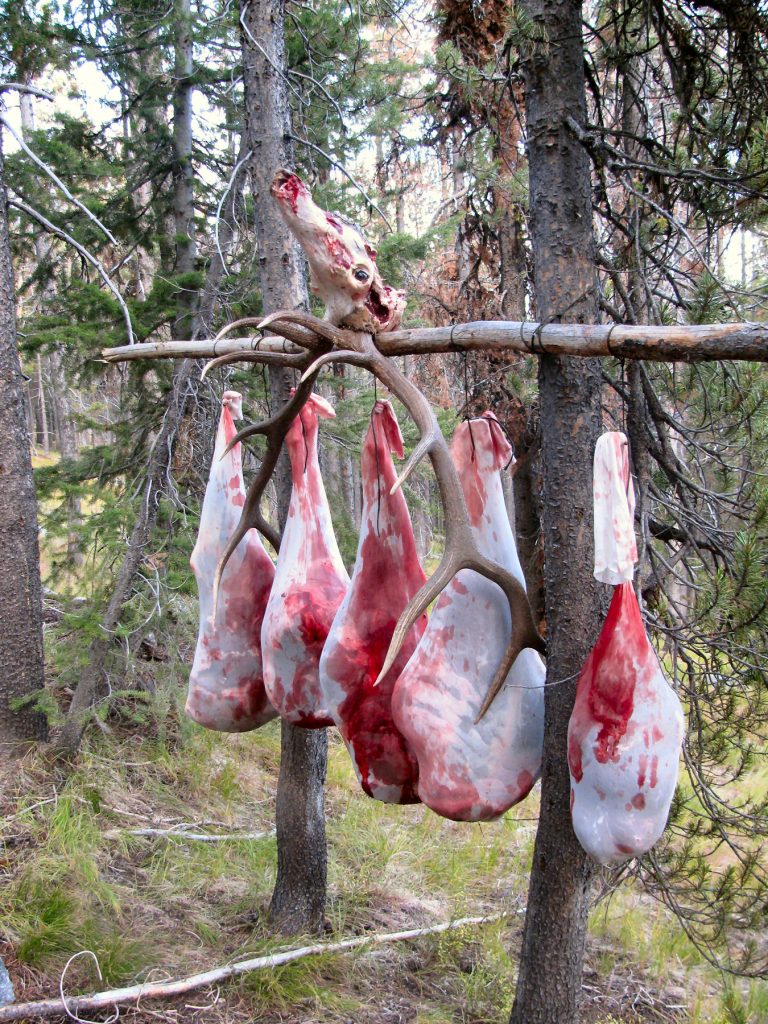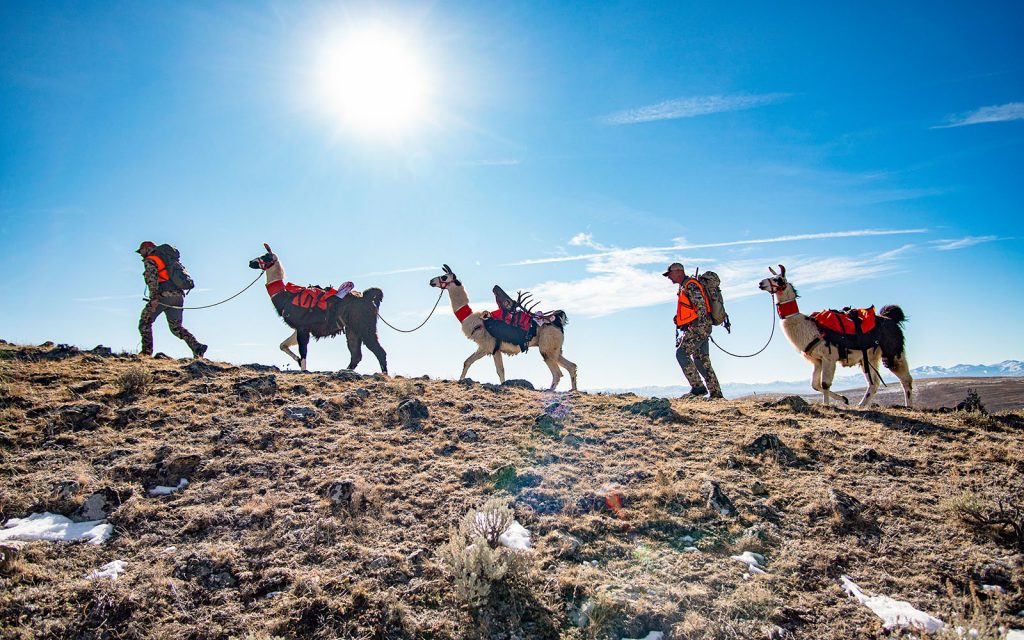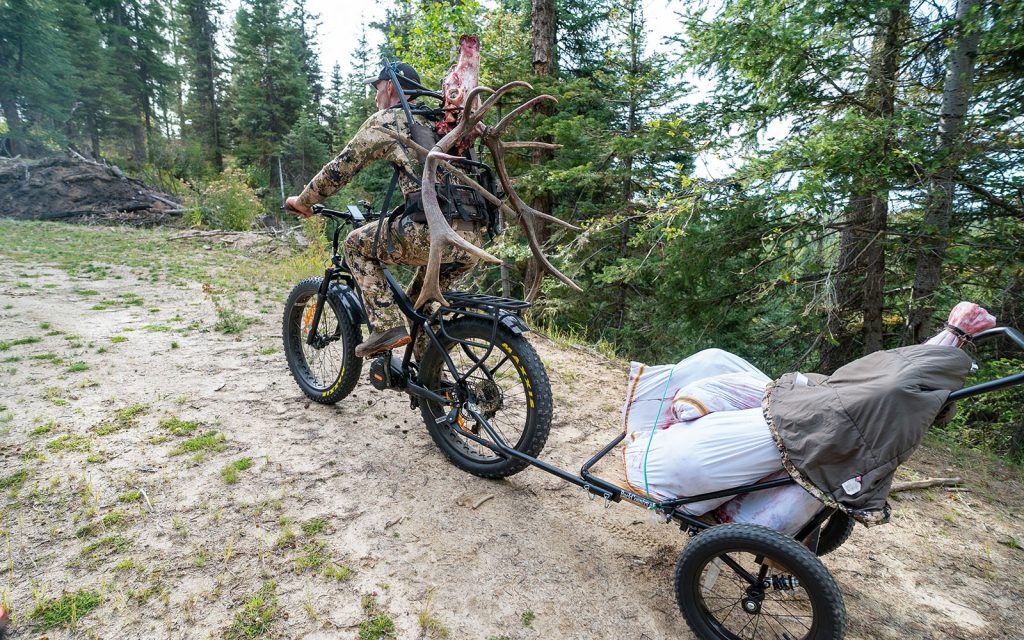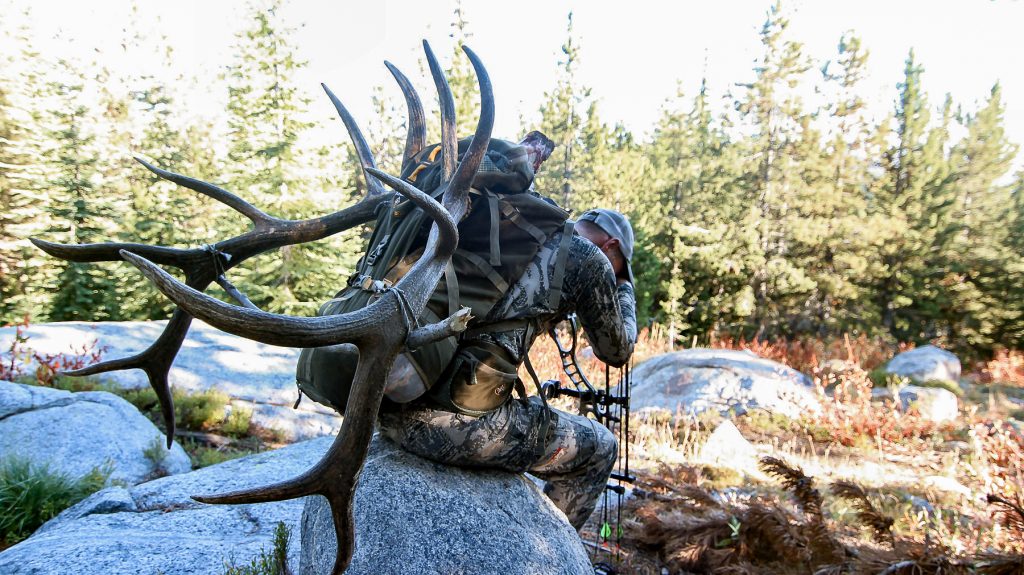
MODULE 14 - PACKING YOUR ELK
CHAPTER 1: LOADED DOWN

Elk are heavy animals! Regardless of how you plan to pack one out, you are still going to have to handle the quarters and maneuver the elk around for processing. To give you an idea of what to expect, here are some average weights of bull elk quarters and elk meat. These are not guesses, but actual weighs obtained by hanging actual quarters on a scale at the butcher’s shop.
Average weights (average bull elk):
Front quarter (bone in) – 36 lbs
Front quarter (boned out) – 28 lbs
Hind quarter (bone in) – 66 lbs
Hind quarter (boned out) – 58 lbs
Miscellaneous meat (neck, brisket, ribs, backstrap, tenderloins) – 56 lbs
I’m sure we’ve all heard the stories of someone packing 180 pounds on their back for 11 miles. The truth is, that probably isn’t accurate. I’m not saying that someone hasn’t done that before, but some of the weights that get mentioned after a tough pack out are probably a little higher in our minds than they are in reality. I have weighed a handful of my packs in the past. These were packs that were crippling, and I just had to know how much they really weighed. Let’s just say it would be really impressive to put 180 pounds on your back and carry it any measurable distance…let alone 11 miles!
Realistically, I have found that packing an elk out for more than a half-mile will usually take four man-trips if you are planning on carrying “moderate” loads. A reasonable way to break this up would be a front quarter plus half the miscellaneous meat for two of the trips (average of 56-64 lbs), and a single hind quarter for the other two trips (58 – 64 lbs). You will also have the head/antlers and any gear you are carrying with you to distribute over those loads.
If you are hunting alone, or it’s just you and one other person and you only want to make one trip each, you could double up those loads. However, keep in mind that you will likely be carrying in excess of 120 pounds each – and that is for an average elk. Again, if you have to go very far or the terrain is difficult – or you kill a big bull – this is going to be a challenge, to put it lightly.

I hunt primarily out of a base camp or truck camp and return to camp each night. This style of hunting usually keeps me within 5 miles of an access road. In the past 20 years, the average distance of my packs has been just under 2 miles. I consider myself fortunate, but I can vividly remember nearly every pack out. Packing an elk out is not easy, and it is not what most people would consider to be fun. But, it is an essential part of every successful hunt, so it’s important to be prepared and have a plan in place ahead of time.
As I mentioned previously, elk are heavy animals. That phrase needs to be put in bold letters….ELK ARE HEAVY ANIMALS! You will not be dragging an elk much farther than a few feet. I have heard stories of elk falling within 100 yards of a road, and with the downhill terrain, the hunters were able to drag the elk down the hill and slide it into the back of their truck….whole. Trust me, this is the exception, and definitely not the norm. Don’t plan for this kind of luck.
Instead, make a realistic plan for how you are going to get your elk packed out safely and timely. I will mention three primary methods for packing elk: pack animals, bikes, and on your back.
PACK ANIMALS
I have known a few people that I would include in the category of pack animals. However, the primary pack animal for the backcountry is a horse or mule. If you are lucky enough to have good pack stock, they can be worth their weight in gold when you get an elk on the ground.
A good horse or mule can pack out an entire elk in a single trip. You will have to make the hike out to wherever your horses are, as well as back in to the elk, and the final hike back out with the horses loaded down. However, your back will be under minimal stress for these trips.
If you aren’t fortunate enough to have horses or to hunt with a partner who does, all hope is not lost. Many outfitters and packers will hire out their services to pack your elk out of the mountains for you. This would require some form of communication between you and the packer, and a well-communicated plan. A simple call from a satellite phone with GPS coordinates to your location might save you several hours and a few hundred pounds of struggle under heavy loads. And while it won’t cost you the equivalence of owning and feeding a horse for the entire year, you can expect to pay $150-500 depending on where you are.
If horses or mules are completely out of the question for you, I do know a handful of hunters who have adapted and own llamas, alpacas, or goats that they use for packing. These smaller pack animals aren’t capable of carrying the same weights as a horse or mule, but 2-3 llamas require far less maintenance than horses and can definitely minimize the chore of packing an elk.
I had the opportunity to take llamas with me on an elk hunt, and they are a game-changer for sure. We rented four llamas from Beau Baty (www.WildernessRidgeTrailLlamas.com) at the recommendation of Randy Newberg, and the llamas were incredible. No drama, no rodeos, and they packed a good-sized load. On average, each llama will carry around 70lbs of gear or meat, which meant we were able to hike into camp without any weight on our backs. Then, when we shot an elk, the llamas packed it all back to camp. I will definitely be utilizing llamas on future backcountry adventure!
BIKES
If pack animals just aren’t an option for you, but you don’t want to carry the weight on your back very far, “bikes” – motorized or non-motorized – might be an option to consider.
Some areas are open to motorized travel on specified trail systems and roads. Having access to a motorcycle or ATV can make some pack trips more accessible. As always, know the regulations for the area you are hunting. If you choose to use a motorcycle or ATV, use it responsibly. Illegal off-road and off-trail use of motorized vehicles is a major issue in many western states.
For areas that are closed to motorized travel, you may be able to pedal your way closer to your elk. I don’t want to paint a picture of a hunter hauling half an elk out on his back while strolling comfortably along a steep mountain trail on a mountain bike. In fact, I would personally prefer to hike with an elk quarter on my back versus balancing on a bike seat with the same load.

However, I have found that a sturdy trailer towed behind a mountain bike or an E-bike can be a great way to access – and pack an elk out of – remote areas that are closed to motorized travel.
Again, be sure you know the regulations for travel and access before you head in. Regulations, particularly for E-bikes, are not always clearly defined, and you will definitely want to make sure you know exactly what the legal modes of travel are before you go.
Several times in the past, I have personally used a mountain bike or E-bike combined with a heavy duty trailer to shave several miles off the pack-outs of multiple elk. I still have to carry the quarters out to a point where I can get the bike/trailer in to, but from there, I’m able to load the entire elk onto the trailer and peddle my way back to the truck on a gated road.
Be sure to carry extra tubes for you bike and trailer tires, as well as a small tool kit. And be sure to take it slow going down even the slightest hills! The weight of an elk in the trailer can easily overcome the weight of a mountain bike, even with a full-sized human sitting on its seat! While the rodeo may not be as exciting as those that can happen when packing elk with horses or mules, an out-of-control bike trailer loaded down with elk meat can still turn disastrous very quickly.
ON YOUR BACK
The reality of this topic is that more elk are carried out of the mountains on the backs of hunters than by any other method. If this is the situation you are expecting, it’s important to be prepared. There are three things you need to have planned out in advance if you will be bringing your elk out on your back: Physical Conditioning, Limitations, and your Pack.
Now would be a good time to go back and re-read the module on Physical Conditioning. Being in good shape will increase your chances for success. Your conditioning will really become apparent after hunting for 6-8 days in the rugged terrain that elk call home. However, the quickest way to find the weaknesses in your off-season workout program is to load an elk on your back and start the long hike out to the trailhead.
After just a few minutes of packing these heavy loads, you will be able to readily identify every weak, tired, or untrained muscle in your body. Ankles, quadriceps, hip flexors, lower back, shoulders, lungs – they will all start screaming at you at some point.

Your dedication to off-season workouts won’t keep them from screaming, but it will determine how far you make it down the trail before they start reminding you exactly where they are located. Be sure your off-season Physical Conditioning includes some hikes with heavy loads to find out where these weak points are before you are packing out your elk.
Know your limitations. Going all the way back to the first Module on Planning Your Hunt, consideration should be given to the area you plan to hunt based upon a few possible limiting factors. The first limiting factor is whether you are hunting alone or with a partner. A good partner not only adds to the level of your success, but also becomes a valuable asset when you have an elk to pack out! If you are hunting alone, the chore of packing the elk out is easily doubled. This factor also plays a part in the next limitation, and that is distance.
If you are hunting alone, you will likely need to consider how far you can reasonably pack out an elk. Even if you have a partner there to help, it is wise to consider how far you will be packing the elk, and not hunt farther in than you are able to pack the elk out.
The last factor to consider if you are planning to pack the elk on your back is your equipment, specifically your pack. If you are hunting in a 1200 cubic inch day pack, you won’t be carrying much elk meat with you, especially on that first trip out. Since hauling elk meat out on a pack is the most common means of transportation in the backcountry, I’ve saved an entire chapter to detail this adventure.
Click ‘Next Chapter’ Below to Continue to Chapter 2: It’s All On Your Shoulders





